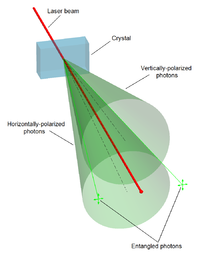
Photo from wikipedia
Photonic entanglement swapping, the procedure of entangling photons without any direct interaction, is a fundamental test of quantum mechanics and an essential resource to the realization of quantum networks. Probabilistic… Click to show full abstract
Photonic entanglement swapping, the procedure of entangling photons without any direct interaction, is a fundamental test of quantum mechanics and an essential resource to the realization of quantum networks. Probabilistic sources of nonclassical light were used for seminal demonstration of entanglement swapping, but applications in quantum technologies demand push-button operation requiring single quantum emitters. This, however, turned out to be an extraordinary challenge due to the stringent prerequisites on the efficiency and purity of the generation of entangled states. Here we show a proof-of-concept demonstration of all-photonic entanglement swapping with pairs of polarization-entangled photons generated on demand by a GaAs quantum dot without spectral and temporal filtering. Moreover, we develop a theoretical model that quantitatively reproduces the experimental data and provides insights on the critical figures of merit for the performance of the swapping operation. Our theoretical analysis also indicates how to improve state-of-the-art entangled-photon sources to meet the requirements needed for implementation of quantum dots in long-distance quantum communication protocols.
Journal Title: Physical review letters
Year Published: 2019
Link to full text (if available)
Share on Social Media: Sign Up to like & get
recommendations!